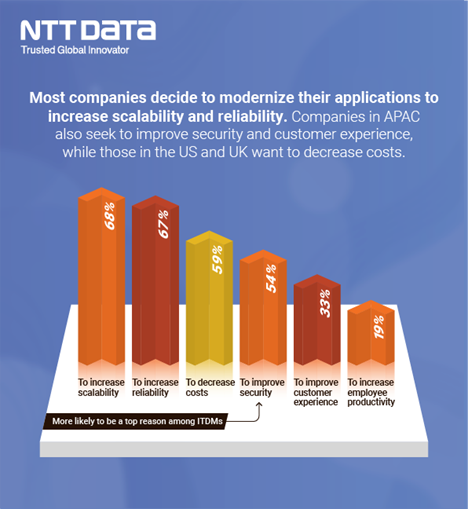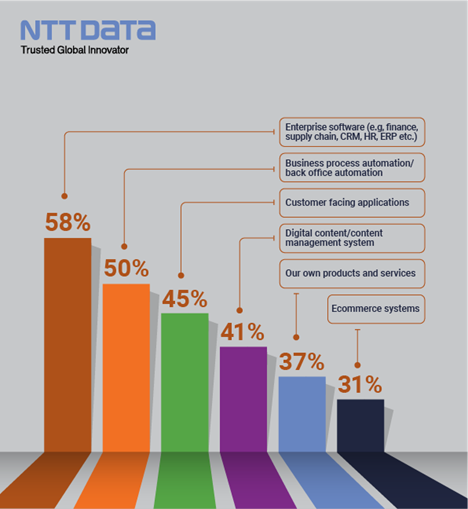Aligning Application Modernization to Business Realities
- March 09, 2023
A realistic, relatable, and relevant guide
In the next wave of modern enterprises, agility, resilience, and scalability will be the prime tenets of digital enablement. However, legacy systems built on monolithic, rigid, incompatible (and comparatively expensive) frameworks do not necessarily align with these tenets. Such systems do not support modern technologies like microservices, cloud, or open-source and barely provide room for agile build-and-release cycles. In fact, some experts point out that reliance on legacy applications is the main reason 90% of businesses fail to harness the full potential of digital technologies.
Application modernization is the key to breaking this legacy problem and running the innovation cycle without deceleration or incurring unmanageable technical debt. At the intersection of business and IT, it can boost collaboration efficiency, security, and overall productivity, add a competitive edge, elate the customers, and ramp up revenue.
Undeniably, the rising demand for modern infrastructure ensuring business continuity is a significant driver of application modernization services. This can be broken down into individual use cases like Fig. 1 below highlights:

Fig 1: Modernization Use Cases for an Application Portfolio
Source: State of Application Modernization Report
Another recent report I went through nominated enterprise-facing applications as a priority for most companies from the modernization perspective:

Fig 2: Top application platforms prioritized by enterprise for modernization initiatives
Source: The State of Application Modernization, 2021
And yet, many companies fall short in their modernization exercises, often leading to failed initiatives, sunk costs, poor experience, and eventual change of plans.
Why? Let’s dig deeper
As imperative as application modernization is, most projects fail to truly transition from monolith to microservices, migrate to the cloud, or even expose functionalities with APIs. From a strategic vantage, it usually boils down to one of three reasons — IT and business misalignment, changing business priorities, and the technology landscape. These reasons make it hard to map dependencies and activities. From the execution viewpoint, a slew of common challenges seem possible:
- High initial costs
- Tool/skill fatigue for diverse portfolios
- Vendor lock-ins
- Difficult-to-break monoliths
- Siloed applications
- Resistance to change by stakeholders
- Lack of understanding of defunct middleware frameworks like WebLogic and JBoss
- Risky to split components like UI and database
Unique problems require unique perspectives and solutions
Conventional prioritizing and optimizing initiatives are not as effective in this endeavor. In the words of one of the Cheshire Cat, in Alice in Wonderland (one of my favorite Lewis Carroll characters), “Choosing a road depends on where you want to go.”
Just like the advice given to Alice, the key to success in application modernization ultimately boils down to understanding the current state, identifying the desired state, and then finding a path between the two. Whether you want to lift and shift, refactor, rearchitect, re-platform, rebuild, or even replace components, the foundational strategy for successful legacy app modernization is to thoroughly assess candidate applications.
Gartner® recently published “How to Start and Drive Your Modernization Strategy.” In this report, Gartner highlighted how applications and software engineering leaders must ensure their modernization plan is technology-focused and not overly complicated. Five key takeaways from the report include:
- Trial and error — get started with a mixed team
This will enable organizations to use cross-functional products, processes, skills, and technologies to specify quantifiable benefits, associated risks, and potential opportunities. Rather than developing the complete set of decisions and approaches, the team will work to refine them with continuous feedback and iterative analysis. - Map actions to outcomes that maximize value potential
This step helps align short-term tactical fixes and long-term strategic changes with accurate business outcomes. It mandates decision-making and risk, value, cost, and impact analysis. Organizations need to develop a vision and correlate the transition from the current state to the desired one by listing high-value assets and pain points before analyzing how modernization will help them perform better. - Weigh readiness to change and prioritize accordingly
Now that organizations have taken care of application needs. Next, they need to secure the business end of things. To answer the question, “Is the business willing to accommodate the change?” the focus team needs to conduct business process analysis and application health assessments to capture the tools and criteria for each layer, domain, and process. - Forecast, prepare, and sustain
Sustainable modernization is the only modernization. Organizations must perform a gap analysis to understand the upskilling needs for the next five years. Then, they must adopt and integrate new processes to keep the modernized applications running without downtime. This can include (but is not limited to) cloud computing, containerization, microservices, and orchestration and automation. - Balance progress with long-term benefits
Balance near-term decisions against the long-term cost of maintaining and extending the applications. Ensure that the technology choices can be used at any scale with the same level of maintainability and a path for future business innovation. Create success metrics to measure and evaluate quality regularly.
These steps do not specify directions. Businesses can use containers or Kubernetes. They can modernize ‘n’ numbers of applications. At NTT DATA, we advise our clients to perform these steps modularly while keeping the business realities in mind. Ultimately, we all agree that applications are the backbone of the digital business, impacting everyone, from employees to leaders to customers.
Impeccable application management can deliver business excellence
Navigating the changing business landscape requires consolidation, repurposing, or restructuring of applications to extract additional business value. Especially for a growing business that needs custom applications with flexible addition of functionalities.
At NTT DATA, we understand that Application Management requires innovation and maintenance to truly add value. We offer Application Development and Modernization services that bring new life to your IT infrastructure by improving speed, reliability, and integration capabilities. You can proceed on your digital transformation journey at your own pace while scaling and optimizing processes for the best results.
Ready to take the first step towards modernizing your legacy systems? Visit our Application Services page to learn how we can help.
Subscribe to our blog




